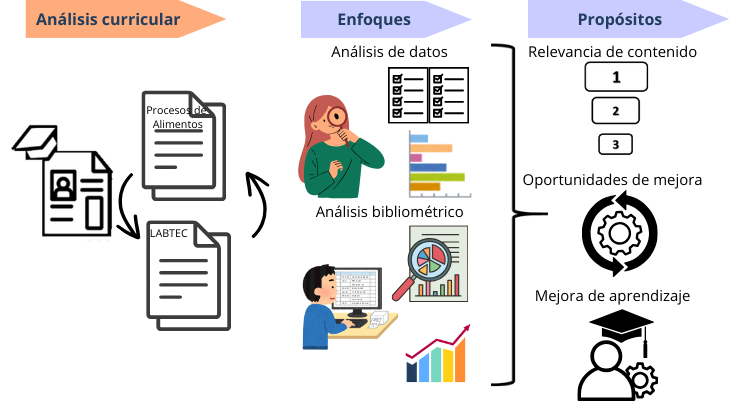Análisis de la interrelación de los contenidos temáticos de las asignaturas Procesos de Alimentos y Laboratorio de Tecnología de Alimentos de la licenciatura en Química de Alimentos
Conteúdo do artigo principal
Resumo
Nos modelos educativos contemporâneos, destaca-se a inter-relação entre diversas áreas e dimensões do conhecimento com o propósito de potencializar a eficácia do processo de ensino-aprendizagem. Essa abordagem busca estabelecer conexões significativas entre disciplinas distintas, abordando fenômenos ou objetos de estudo a partir de múltiplas perspectivas, comumente conhecido como interdisciplinaridade. Aplicar a interdisciplinaridade nos planos de estudo universitários é muito importante para que os estudantes adquiram uma compreensão integral e aplicada das disciplinas em que se formam, promovendo a aprendizagem combinando várias áreas para abordar problemas complexos de maneira integral e não fragmentada.
O presente trabalho tem como objetivo realizar uma análise do conteúdo e da estrutura do programa de estudos das disciplinas Processos de Alimentos (1716) e Laboratório de Tecnologia de Alimentos (1809) do curso de Química de Alimentos. O objetivo é identificar os elementos comuns entre ambas disciplinas, dando prioridade aos conhecimentos básicos que possibilitem, por meio de uma compreensão teórica sólida, a execução experimental de diversos processos tecnológicos de modificação de alimentos. Dessa forma, será possível identificar como ambas as disciplinas se relacionam e avaliar como essa conexão influencia na construção do conhecimento dos estudantes.
Detalhes do artigo
Citas en Dimensions Service
Referências
Abdul Ghani, A. G., Farid, M. M., Chen, X. D., & Richards, P. (2001). Thermal sterilization of canned food in a 3-D pouch using computational fluid dynamics. Journal of Food Engineering, 48(2), 147-156. https://doi.org/10.1016/S0260-8774(00)00150-3
Aria, M., & Cuccurullo, C. (2017). bibliometrix: An R-tool for comprehensive science mapping analysis. Journal of Informetrics, 11(4), 959-975. Elsevier.
Bipartite Chart / Visualize with PlotDB. (s. f.). Recuperado 24 de marzo de 2024, de https://plotdb.com/chart/2124
Cervantes, L., Estévez, B., & Soria, C. (2007). La interdisciplinariedad a partir de la química general: una vía para lograr el aprendizaje desarrollador. Revista Cubana de Química, 19(3), 23-25.
Erdogdu, F. (2023). Mathematical modeling of food thermal processing: Current and future challenges. Current Opinion in Food Science, 51, 101042. https://doi.org/10.1016/j.cofs.2023.101042
International Conference on Food Chemistry and Hydrocolloids. (2016). Conference Series LLC. Toronto, Canada.
Kay, S. S., Delgado, S., Mittal, J., Eshraghi, R. S., Mittal, R., & Eshraghi, A. A. (2021). Beneficial effects of milk having A2 β-casein protein: Myth or reality? The Journal of Nutrition, 151(5), 1061-1072. https://doi.org/10.1093/jn/nxaa454
Malik, M., Rehan, Yawson, R. M., & Hensel, D. (2009). Destination 2025: Focus on the future of the food industry. A collaboration between the BioBusiness Alliance of MN and Deloitte Consulting LLP. Disponible en: https://ssrn.com/abstract=1418204
Martín, X. (1992). El role-playing, una técnica para facilitar la empatía y la perspectiva social. CL & E: Comunicación, lenguaje y educación, 15, 63-68.
Rodríguez-Ramos, F., Tabilo, E. J., & Moraga, N. O. (2021). Modeling inactivation of Clostridium botulinum and vitamin destruction of non-Newtonian liquid-solid food mixtures by convective sterilization in cans. Innovative Food Science & Emerging Technologies, 73, 102762. https://doi.org/10.1016/j.ifset.2021.102762
Simpson, R., Nuñez, H., & Ramírez, C. (2021). Fundamentals of material balance in food processing. En S. M. Jafari (Ed.), Engineering Principles of Unit Operations in Food Processing (pp. 107-133). Woodhead Publishing. https://doi.org/10.1016/B978-0-12-818473-8.00012-8
Stoforos, N. G. (2010). Thermal process calculations through Ball’s original formula method: A critical presentation of the method and simplification of its use through regression equations. Food Engineering Reviews, 2(1-2), 1-16. https://doi.org/10.1007/s12393-010-9014-4
SIAL Insights. (2020). Key factors in the global food industry. Recuperado de https://imexmanagement.com/assets/shows-documents/SIAL-Insights-White-Paper.pdf
Tejera Chillón, N. de la, Cortés Sendón, C., Viñet Espinosa, L. M., Pavón de la Tejera, I., & Tejera Chillón, A. de la. (2019). La interdisciplinariedad en el contexto universitario. Panorama Cuba y Salud, 14(Extra 1), 58-61.
UNAM-Facultad de Química. (2023). Programas de estudio, Procesos de Alimentos 1716. Recuperado 30 de noviembre de 2023, de https://quimica.unam.mx/wp-content/uploads/2017/03/1716procesdealimentosQA.pdf
UNAM-Facultad de Química. (2023). Programas de estudio, Laboratorio de Tecnología de Alimentos 1809. Recuperado 30 de noviembre de 2023, de https://quimica.unam.mx/wp-content/uploads/2017/03/1809labtecQA.pdf

Educación Química por Universidad Nacional Autónoma de México se distribuye bajo una Licencia Creative Commons Atribución-NoComercial-SinDerivar 4.0 Internacional.
Basada en una obra en http://www.revistas.unam.mx/index.php/req.




